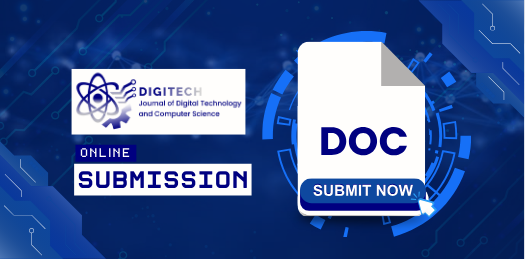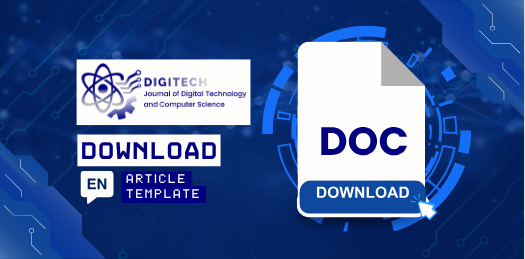Web Based Sales Information System Using the Waterfall Method for Cashier and Product Management
DOI:
https://doi.org/10.61220/digitech.v3i1.20253Keywords:
E-commerce, Information system, Sales platform, Transaction management, Waterfall methodAbstract
This article presents the development of a web based sales information system for e commerce named Comerch using the Waterfall method. E commerce offers convenient online transactions yet imposes challenges in managing complex sales processes. The study aims to design and implement a system that supports transaction processing, product management, and an accessible and efficient platform. The Waterfall stages applied include requirements analysis, system design, coding, integration, and testing. Findings show that Waterfall enabled a structured and efficient development pipeline and smooth integration of system components. The resulting system provides core functions including product management, payment transactions, and real time reporting which improve operational efficiency and user experience. Scenario based testing confirms that the system performs as expected. Black box testing across forty six scenarios achieved one hundred percent functional validation. The study contributes a practical reference for developing sales information systems for small and medium enterprises and for practitioners seeking predictable and well documented development cycles.
References
[1] R. Anggraeni dan I. E. Maulani, “Pengaruh Teknologi Informasi Terhadap Perkembangan Bisnis Modern,” Jurnal Sosial Teknologi, vol. 3, no. 2, hlm. 94–98, Feb 2023, doi: 10.59188/jurnalsostech.v3i2.635.
[2] Y. S. Mulyani, “E-Commerce Solusi Pemasaran UMKM Dalam Mengembangkan Industri Pariwisata Di Tengah Pademi Covid-19 (Studi Kasus UMKM di Kota Tasikmalaya),” Khasanah Ilmu - Jurnal Pariwisata Dan Budaya, vol. 12, no. 2, Art. no. 2, Sep 2021, doi: 10.31294/khi.v12i2.11293.
[3] D. Riswan, H. E. R. Putra, dan R. N. Saputra, “Pengembangan Sistem Rekomendasi Berbasis Kecerdasan Buatan Untuk Meningkatkan Pengalaman Pengguna Di Platform E-Commerce,” Jurnal Komputer Teknologi Informasi dan Sistem Informasi (JUKTISI), vol. 2, no. 3, Art. no. 3, Feb 2024, doi: 10.62712/juktisi.v2i3.145.
[4] A. Adenowo dan B. Adenowo, “Software Engineering Methodologies: A Review of the Waterfall Model and Object- Oriented Approach,” International Journal of Scientific and Engineering Research, vol. 4, hlm. 427–434, Sep 2020.
[5] S. Yulina, S. P. Arifin, dan Y. D. L. Widyasari, “PELATIHAN PENGEMBANGAN KOMPETENSI SISWA DALAM MERANCANG UI/UX MENGGUNAKAN FIGMA PADA SMK MUHAMMADIYAH 2 PEKANBARU,” Jurnal Pengabdian Masyarakat Multidisiplin, vol. 8, no. 1, Art. no. 1, Okt 2024, doi: 10.36341/jpm.v8i1.4982.
[6] C. Ningki dan N. P, “Implementasi Aplikasi Penjualan Produk Tradisional Berbasis Website Menggunakan Metode Waterfall,” Informatik : Jurnal Ilmu Komputer, vol. 19, no. 2, Art. no. 2, Sep 2023, doi: 10.52958/iftk.v19i2.6149.
[7] R. Risald, “IMPLEMENTASI SISTEM PENJUALAN ONLINE BERBASIS E-COMMERCE PADA USAHA UKM IKE SUTI MENGGUNAKAN METODE WATERFALL,” Journal of Information and Technology, vol. 1, hlm. 37–42, Agu 2021, doi: 10.32938/jitu.v1i1.1393.
[8] M. Hendriawan, T. Budiman, V. Yasin, dan A. S. Rini, “PENGEMBANGAN APLIKASI E-COMMERCE DI PT. PUTRA SUMBER ABADI MENGGUNAKAN FLUTTER,” Journal of Information System, Informatics and Computing, vol. 5, no. 1, Art. no. 1, Jun 2021, doi: 10.52362/jisicom.v5i1.371.
[9] S. Aisyah, R. Amelia, I. Sabrina, dan T. Syahrifah, “PERANCANGAN APLIKASI E-COMMERCE PADA TOKO LILI DENGAN PENERAPAN METODE WATERFALL,” Jurnal Sistem Informasi dan Ilmu Komputer, vol. 5, no. 1, Art. no. 1, Agu 2021, doi 10.34012/jurnalsisteminformasidanilmukomputer.v5i1.1917.
[10] T. Haryati, D. H. Kusuma, dan H. Ferliyanti, “Penerapan Metode Waterfall Sebagai Pengembangan Perangkat Lunak Sistem Informasi Penjualan PT. Arta Putra Nugraha Karawang,” Simpatik: Jurnal Sistem Informasi dan Informatika, vol. 1, no. 2, Art. no. 2, Des 2021, doi: 10.31294/simpatik.v1i2.955.
[11] R. A. Ghani, N. W. Azani, S. N. Auliani, S. Maharani, M. D. Gustinov, dan M. L. Hamzah, “Perancangan Sistem Informasi e- Commerce Berbasis Website Menggunakan Metode Waterfall,” Prosiding Seminar Nasional Teknologi Informasi dan Bisnis, hlm. 99–106, Jul 2022.
[12] A. Hidayat, F. Faisal, K. P. Harum, dan M. M. Fakhri, “Sistem Informasi Permintaan Barang Atk (Alat Tulis Kantor) Pada Pengadilan Negeri Makassar Kelas Ia Khusus,” Jurnal Media Elektrik, vol. 20, no. 2, hlm. 77–85, 2023.
[13] B. Yuanita, M. M. Fakhri, dan W. Hidayat, “Sistem Informasi Medical Record Pasien Pada Puskesmas Sudu Kec. Alla Kab. Enrekang Berbasis Website,” Journal of Embedded Systems, Security and Intelligent Systems, hlm. 93–100, 2021.
[14] Fariz Rahmat Mulyadi dan Yuda Syahidin, “Rancang Bangun Sistem Informasi Kepegawaian dengan Metode Waterfall,” Explore: Jurnal Sistem Informasi dan Telematika, vol. 12, no. 2, hlm. 186–196, Des 2021, doi: 10.36448/jsit.v12i2.2056.
[15] “A Wearable Sonification System to Improve Movement Awareness: A Feasibility Study.” Diakses: 24 April 2025. [Daring]. Tersedia pada: https://www.mdpi.com/2076-3417/14/2/816
[16] M. Prihandoyo, “Unified Modeling Language (UML) Model Untuk Pengembangan Sistem Informasi Akademik Berbasis Web,” Jurnal Informatika: Jurnal Pengembangan IT, vol. 3, hlm. 126–129, Jan 2018, doi: 10.30591/jpit.v3i1.765.
[17] S. Syauqi dan S. Suendri, “Information System Design of Web-Based Document Archives Management In The Office Bappeda of North Sumatra Province,” Journal of Information Systems and Technology Research, vol. 1, no. 1, Art. no. 1, Jan 2022, doi: 10.55537/jistr.v1i1.66.
[18] M. M. Fakhri, M. S. J. Irmawan, A. S. Alwi, I. F. Asril, N. Q. Ridhaihi, dan D. Fadhilatunisa, “Perancangan Sistem Informasi Manajemen Karyawan Berbasis Website dengan Metode Waterfall,” Jurnal Mediatik, hlm. 35–44, 2023.
[19] Z. A. Hamza dan M. Hammad, “Analyzing UML use cases to generate test sequences,” Jan 2021, Diakses: 24 April 2025. [Daring]. Tersedia pada: https://journal.uob.edu.bh:443/handle/123456789/3923
[20] R. Fauzan, D. Siahaan, S. Rochimah, dan E. Triandini, “Automated Class Diagram Assessment using Semantic and Structural Similarities,” International Journal of Intelligent Engineering and Systems, vol. 14, no. 2, hlm. 52–66, 2021, doi: 10.22266/ijies2021.0430.06.
[21] M. R. Wayahdi dan F. Ruziq, “Pemodelan Sistem Penerimaan Anggota Baru dengan Unified Modeling Language (UML) (Studi Kasus: Programmer Association of Battuta),” Jurnal Minfo Polgan, vol. 12, no. 1, Art. no. 1, Agu 2023, doi: 10.33395/jmp.v12i1.12870.
[22] Y. S. Purbo, F. S. Utomo, dan Y. Purwati, “Analisis dan Perancangan Antarmuka Aplikasi Wisata Menggunakan Metode User Centered Design (UCD),” Jurnal Teknologi Terpadu, vol. 9, no. 2, Art. no. 2, Des 2023, doi: 10.54914/jtt.v9i2.977.
[23] M. Muauwanah, H. D. Saputra, M. Afifudin, dan M. Y. P. Chusnani, “Implementasi Pengujian Black Box pada Form Login E-Learning di Universitas Airlangga,” Jurnal Sistem Informasi, Manajemen dan Teknologi Informasi, vol. 2, no. 2, Art. no. 2, Jul 2024, doi: 10.33020/jsimtek.v2i2.727.
[24] “Keamanan Sebuah Sistem Point of Sale: Sampai Sejauh Mana?” Diakses: 24 April 2025. [Daring]. Tersedia pada: https://www.opaper.app/blog/keamanan-point-of-sale
[25] C. A. Pamungkas dan A. Lutfiyani, “Sistem Informasi Kasir pada Usaha Serba Rasa Food Program Wirausaha Merdeka IPB University Berbasis Website Menggunakan Metode Waterfall,” Jurnal Penelitian Inovatif, vol. 4, no. 2, Art. no. 2, Apr 2024, doi: 10.54082/jupin.314.
[26] Lesmono, I. D. (2018). RANCANG BANGUN SISTEM INFORMASI PENJUALAN SEPATU BERBASIS WEBSITE DENGAN METODE WATERFALL. Swabumi, 6(1). https://doi.org/10.31294/swabumi.v6i1.3316
Downloads
Published
Issue
Section
License
Copyright (c) 2025 Awaluddin, Muhammad Fadhil Mu’min, Riandy, Syahril Ramadhan, Muhammad Nur Faiz, Ahmad Khairul Shiddiq (Author)

This work is licensed under a Creative Commons Attribution 4.0 International License.








 Email:
Email: 
